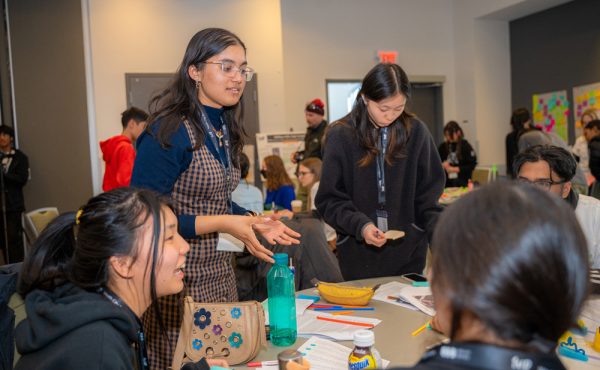ED: Other than a general sense of making Toronto and area interesting, the following articles have nothing in common other than the byline.
In yesterday’s Toronto Star Ideas section I wrote about goats. Inspired by the urban goats at the Riverdale Farm and some gravity-defying GTA goats found north of Brampton (pictured above), the piece is a brief exploration into how goats intersect with our lives. Though not addressed too deeply in this article, I’ve started to wonder if goats will make a comeback on the urban landscape as fuel prices skyrocket and we look for sustainable and local sources of food.
In his “Proverbs of Hell” the 18th-century, revolutionary English poet William Blake wrote, “The lust of the goat is the bounty of God.” The phrase alludes to a reputation that ranges from delightfully mischievous to the embodiment of evil.
—
Though there is a growing movement to allow city dwellers to keep small livestock such as goats in their yards as a sustainable and local food source, urban goat connoisseurs can get their fix at a handful of nearby locations. Ten minutes north of Brampton on Heart Lake Rd. is Downey’s Farm Market — “A Family Farm for Family Fun” — which includes a petting zoo with a variety of animals. Dominating the barnyard are narrow wooden aerial walkways.
Visitors can buy a handful of feed, place it in a cup on a pulley system, and hoist it up to one of the two crow’s nests in the hope of enticing a goat to exercise the mountaineering skills hidden deep in its genetic code.
On one busy Sunday, the farm was teeming with children, but the goats weren’t climbing. “They’re over-fed today,” explains a farmhand. “They aren’t going to climb anything.” They were, however, content to be petted by a steady stream of squealing city children.
John Downey, farmer and patriarch, introduced me to his goats on a quiet weekday. Without the children around as a distraction, suspicious goat eyes watched us enter the paddock in silence. It’s disconcerting — they look straight into your soul. Some are skittish and move away; others, if you don’t pet them promptly, will ram your leg until you do.
 In the recent issue of Building Magazine, the Canadian building and development industry publication, I wrote a profile on Glen Murray, the recently appointed head of the Canadian Urban Institute. The discussion was focussed around “what makes a great city” and Murray’s thoughts will likely be of interest to many Spacing readers. Read the rest here:
In the recent issue of Building Magazine, the Canadian building and development industry publication, I wrote a profile on Glen Murray, the recently appointed head of the Canadian Urban Institute. The discussion was focussed around “what makes a great city” and Murray’s thoughts will likely be of interest to many Spacing readers. Read the rest here:
The CUI is a fitting home for Murray, and he is taking over from another former big city mayor, David Crombie, Toronto’s reform mayor from the 1970s. “My feet are getting into those tiny, perfect shoes,” jokes Murray, referencing Crombie’s Tiny Perfect Mayor moniker. The CUI is a non-profit organization that “brings together experts from different disciplines to connect people, money and ideas to build strong communities in Canada and internationally.” Established by the erstwhile Metropolitan level of Toronto’s municipal government, the CUI is now an independent body and self-sustaining.
“It’s the only applied urban public policy organization in Canada,” says Murray. “One of the challenges in the country is a real lack of innovation in rethinking our urban systems, places that generate wealth and the mechanisms needed to capitalize on what we have. There is a lot of hidden capacity here.” Murray points to the CUI’s generation of brownfield, greenfield and sustainable energy networks that try to capture some of the organizations independent of municipal governments that have the potential to propel city building in the right direction.
—
One of the impediments to fostering “great cities” in Canada that Murray says needs to change is the anti-urban culture that permeates the county and is exemplified by the current disdain the Stephen Harper government shows to municipalities. “The antiurban culture in Canada is downright stupid. It sells and sells cheap,” laments Murray. “Other countries are moving to support regional urban areas. London (UK) put out a white paper on the city that included sections on its financial stake in relation to trade and regulation but also included subways, transit, and even sections on how London can access the Muslim World. Imagine [federal Finance Minster] Jim Flaherty talking about that?”
Top photo by Liz Clayton.




8 comments
Richard Florida. Glen Murray. Cage Match!
The problem isn’t Murray doing big thinking for Toronto it’s getting the City to do some listening. See here (comments section)
http://www.torontolife.ca/blog/preville-politics/2007/oct/19/why-panel-experts/
I wish people posted more comments on Phillip’s new TO Life blog like they used to, but they require registration now.
Nothing kills blog comments like making people register.
Mark> Good link.
Murray’s observation about the City’s “Toronto Knows Best Attitude” being a killer is an important one, but I don’t think it’s completely accurate. Toronto does draw upon ideas from other cities and their experts, but only when it will help to give credibility to the City’s agenda.
For example, out of all the “experts” behind public squares around the world to choose from, Dan Biederman of NYC’s private-sector funded and privately managed Bryant Park, was deemed worthy of input into the City’s Nathan Phillips Square revitalization efforts. Coincidence?
At the same time, much is being made of Toronto’s new “innovative” “Regent Park Model” of “public housing revitalization,” although similar ideas have not only been tried in other cities (including NYC), but have failed spectacularly. Not surprisingly, no one cites those examples or “experts.” In this case Toronto’s myopic view is especially troubling, because this proven-to-be-risky, untested-in-Toronto model is being rolled out across the GTA (next up is Lawrence Heights) without first finding out whether or not it will have the promised effects in Regent Park.
So I suggest that it’s not a “Toronto Knows Best” attitude, but rather a “We Know Best” closed-mindedness at City Hall that is the problem.
Torontonians themselves have loads of experience and unique ideas, but they are rarely listened to, and when they are, their ideas are often appropriated and hopelessly mangled by politicians and bureaucrats who are convinced that they (or more often than not, high-paid private sector consultants) know better. I’m thinking specifically of Multistory Complex’s Street Food Vending Project, but I’m willing to bet that there are a lot of other examples…
melissa> and how about street furniture ? How much of the input from citizens was used ? In my mind, based on being at a visioning session, not much. Personally I am starting to believe that all City consultations with the public are a charade.
Its not a charade. It just depends on the department and the type of project. College Street streetscape was improved simply by listening to the public (tho it took a lot of work from the public). Same with a number of issues in the Annex — the City and councillor have listened.
But, other projects legislatively need consultation (bike lanes, ie) but certainly don’t need to have the public comment upon.
I still don’t understand why people like melissa seem to loathe “experts” and put unnecessary praise on the public. Having gone to too many public meeting s I can tell you that only a smidgen of them have good ideas or an understanding of how a city is built. That’s not really their fault since they spend most of their time doing their own professional livelihoods. Then there are the few that are quite talented and can easily adapt and understand the multiple nuances of city-building.
A lot of the experts have worked their lives on these things, gaining valuable knowledge, insight and experience. So to dismiss them outright, which a lot of people do just to have a scapegoat, is just plain lunacy. I hope whatever job Melissa has someone comes along and tells her she’s no good at it because she’s become a professional at it. Its like telling a scientist he/she doesn’t know about microbes because they spend too much time looking in a microscope and not enough time with the microbes.
Maloney,
What I argued up there is that the city is conveniently selective in its use of “experts,” not that “experts” have no value. I absolutely did NOT dismiss them outright. Did you even read what I wrote?!
And I was writing in response to the article Mark posted. Read it. The argument made there was that the city used an “expert panel” of local “experts” with no RELEVANT experience to evaluate its spending over non-local “experts” with relevant experience who might have actually been able to contribute some useful insight into the city’s budget issues.
Which seems to be a common way of looking at “experts”–if you’re an “expert” in one thing, you magically gain credibility in everything. For example, the objective of the city’s Jarvis Streetscape Improvement Project is to improve the pedestrian realm, focusing on heritage buildings, greening the landscape, public art and other “cultural” opportunities, yet the “experts” (consultants) they’ve hired to do the design work are transportation engineers. Transportation engineers are appropriate “experts” for road redesign, but are they appropriate “experts” for public art?
I’ve been reading too much gossip-site snark. Everything relating to goats makes me think of Kim Kardashian…